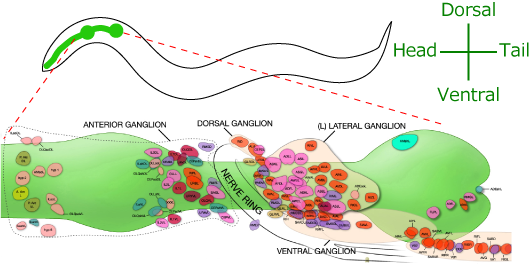<<< Previous page | | Next page >>>
Observation of the whole nervous system
Animals sense the environment around them by sensory neurons. Sensory neurons transmit the information to downstream neural circuits, and the neural circuits process the information and control the behavior. The mechanisms of processing depend on the response characteristics of each neuron and neural circuits.
To understand response characteristic of a neuron, it is required to monitor activities of all upstream neurons. C. elegans is the only animal that the wiring diagram of the whole nervous system is known. Although there are several methods to monitor neural activity, it is difficult to monitor activities of all neurons simultaneously. Thus, methods that monitor responses of each neuron to the same stimulus individually have been widely used.

Figure 1: Head neurons of C. elegans are arranged three-dimensionally around the pharynx (green)
This method is based on the premise that a neuron shows the same response to the same stimuli. However, in many animals, there are random and spontaneous responses that does not depend on the stimulus. This means that a neuron doesn't always show the same responses to the same stimuli. This randomness may prevent from revealing the response characteristics of each neuron.
Although little is known of the meaning of spontaneous neural activities, there is an view that animal's behaviors are decided by interaction between spontaneous activities and stimulus-dependent activities. Therefore, we should monitor responses of all neurons simultaneously and investigate the transmission of spontaneous responses to extract stimulus-dependent activities.
We have set up a CREST collaborative project intended for observation of the whole nervous system. In this project we develop new techniques as follows.
・A specialized confocal microscope that allowed to observe activities of many neurons arranged three-dimensionally.
・Image analysis methods that extract neurons and their activities from 3D-timelapse imaging data.
・Information science methods to annotate each neuron.
・Mathematical analysis methods that reveal characteristics of each neuron and neural circuit by simulating activities of neural circuit.
In this project, we also focus on the following biological phenomena.
・Interaction between spontaneous activities and external stimuli.
・The oscillation circuit that generate spontaneous activities and serpentine motion.
・Which neurons regulate learning, and how to change behavior.
・The mechanism of spatial perception based on temporal information.
We aim for revelation of basic mechanisms of information processing in the nervous system, by investigating neural mechanisms of these phenomena.
Related research: Visualization and analysis of neural activity , Simulation of neurons and neural circuit